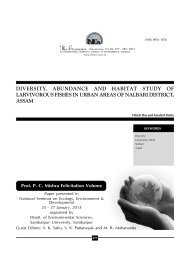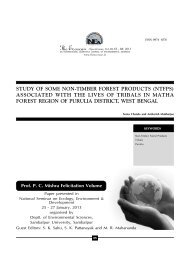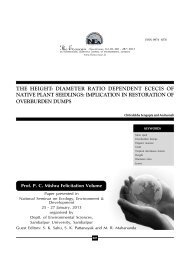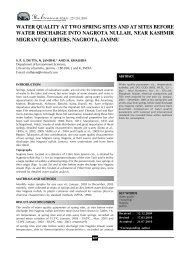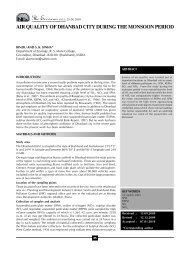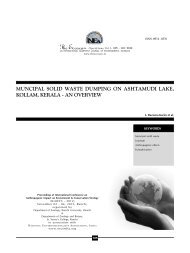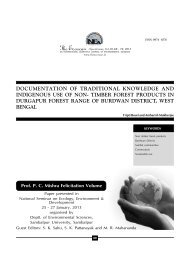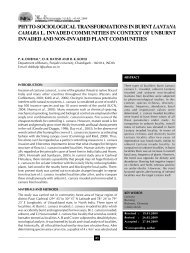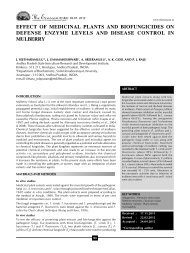full paper.pdf
full paper.pdf
full paper.pdf
You also want an ePaper? Increase the reach of your titles
YUMPU automatically turns print PDFs into web optimized ePapers that Google loves.
NSave Nature to Survive<br />
QUARTERLY<br />
4(1) : 81-82, 2010<br />
A NOTE ON SOME PHYSICO-CHEMICAL CHARACTERISTIC OF<br />
VAJARWADI RESERVOIR, BEED<br />
P.V. PATIL*, M. Y. KULKARNI 1 , A. N. KULKARNI 2 AND A. V. WALANKIKAR 1<br />
P.G. Department of Zoology, Mrs. K. S. K. College, Beed - 431 122<br />
1<br />
V. D. M. D. College, Degloor, Nanded - 431 717<br />
2<br />
P. G. Department of Zoology and Fishery Science College,<br />
Nanded - 431 602<br />
E-mail: drprashantpatil123@yahoo.com<br />
ABSTRACT<br />
INTRODUCTION<br />
All organisms are evolved in the water, water is required for various activities of<br />
animals. It is a vital element in determing the quality of environments overall<br />
social and economic development of any region.<br />
Massive growth of human population, siltation, agrochemicals, construction of<br />
dams, addition of sewage and waste material change the suitability of water. It<br />
contains the soluble detergents, fertilizers, harmful chemicals, degradable as well<br />
as non degradable waste, hospital waste, drainage, municipal waste. Sohani et<br />
al., (2002), Kulkarni et al., (2001), Sakhare and Joshi (2003), Trevedi and Gupta<br />
(1995), Tamlurkar and Ambore (2006) have carried exhaustive study on<br />
physicochemical characteristics of water.<br />
The present study reports some physicochemical parameters of Vanjarwadi<br />
reservoir (70º 38’NL and 18º58’EL) near Beed during 2005 to 2006.<br />
The present work was undertaken to study the<br />
physico-chemical characteristics like<br />
temperature, dissolved oxygen content,<br />
carbondioxide, pH and BOD of Vajarwadi<br />
reservoir constructed for irrigation.<br />
MATERIALS AND METHODS<br />
The study was carried out in the first week of every month at regular intervals from<br />
June 2005 to May 2006.<br />
Experiments were conducted on the field as well as in the laboratory by using<br />
standard methods described by Trivedi and Goel (1986).<br />
RESULTS AND DISCUSSION<br />
Physico-chemical characteristic of Vanjarwadi reservoir are shown in Table 1.<br />
Air temperature ranged 22ºC to 35.5ºC. Water temperature ranged 18ºC to 32ºC.<br />
The temperature is one of the important physical characteristic which directly<br />
influence some chemical reaction in aquatic ecosystem. Current findings are in<br />
the line with earlier finding of Nisar Shaikh and Yeragi (2004).<br />
pH ranged between 8.0 to 8.6. Values of pH may vary in high temperature due to<br />
discharge of CO 2<br />
. Direct relationship of CO 2<br />
with pH has been well documented<br />
by various ecologists (Hutchinson, 1987; Deshmukh and Ambore, 2006). Increase<br />
in pH may be due to the absence of pollutants, low CO 2<br />
content, very high<br />
photosynthesis and rich algal diversity (Welch, 1952).<br />
DO 2<br />
ranged from 5.2mg/L to 8.8mg/L. In present investigation DO 2<br />
fluctuated in<br />
every month. The present of CO 2<br />
in water is because of diffusion, inflow of<br />
groundwater due to decomposition of organic matter, respiration of aquatic<br />
organisms (Welch, 1952). In the present investigation CO 2<br />
ranged between<br />
1.20mg/L to 3.50mg/L.<br />
BOD the most important parameter indicates the presence of organic load in<br />
KEY WORDS<br />
Water chemistry<br />
BOD<br />
Alkalinity<br />
Received : 17.09.2009<br />
Revised : 21.12.2009<br />
Accepted : 14.02.2010<br />
*Corresponding author<br />
81
P. V. PATIL et al.,<br />
Table 1: Physico-chemical characteristics of Vanjarwadi reservoir<br />
Temp 0 C DO 2<br />
CO 2<br />
pH BOD Month<br />
Air Water mg/L mg/L mg/L year<br />
27 26.5 5.3 1.80 8.5 3.15 June 05<br />
26.5 25.0 5.84 1.50 8.4 2.02 July 05<br />
26.0 24.0 6.50 1.53 8.1 3.01 Aug 05<br />
25.0 24.5 7.1 1.20 8.0 1.62 Sept 05<br />
23.5 23.0 8.3 1.36 8.1 3.01 Oct 05<br />
23.0 22.0 8.4 1.50 8.2 4.85 Nov 05<br />
22.0 18.0 8.6 3.50 8.2 5.25 Dec 05<br />
24.0 23.0 8.8 2.90 8.3 7.02 Jan 06<br />
25.0 23.8 7.5 1.50 8.1 3.01 Feb 06<br />
30.5 26.0 7.2 1.60 8.4 3.51 Mar 06<br />
34 30 6.2 1.70 8.5 3.01 Apr 06<br />
35.5 32 5.1 1.50 8.6 2.01 May 06<br />
32.22 24.75 7.07 1.79 8.28 3.45 Mean<br />
±6.80 ±1.62 ±1.22 ±0.64 ±0.22 ±1.48 SD<br />
21.10% 6.5% 17.25% 35.75% 2.65% 12.3% CV<br />
SD = Standard Deviation; CV = Coefficient of variation<br />
water. In present investigation the biological oxidation demand<br />
ranged between 1.62mg/L to 7.02mg/L similar results have<br />
been reported by Varghese and Naik (1992), Mathu Salam<br />
and Ganga Ganesh et al., (2004).<br />
ACKNOWLEDGEMENT<br />
Authors are thankful to Principal Mrs. K. S. K. Alias Kaku College<br />
Beed for providing laboratory facilities and supoort during<br />
completion of work and support.<br />
REFERENCES<br />
Deshmukh, M. and Ambore, N. E. 2006. Seasonal variations in<br />
physical aspects of pollutions in Godwar river at Nanded Maharashtra<br />
India. J. Aqua. Bio. 21(2):<br />
Hutchinson, G. E. 1887. A treaties on Limnology-I Geography, Physics<br />
and Chemistry, john villey and son’s inc. New York<br />
Kulkarni, A. N. and Kanwate, V. S. 2001. Water quality testing of<br />
Seetakhandi reservoir for fish culture. Nat. Conf. Fish and Fisheries<br />
14-15 March, Hyderabad.<br />
Mathu Salam, A. and Ganga Ganesh, D. 2004. Physicochemical and<br />
Biological studies of Tannery effluent pollution ground water in<br />
Tiruchirapalli. Poll. Res. 23(3): 473.475.<br />
Nisar shaikh and Yeragi, S.G. 2004. Some physicochemical aspects<br />
of Tansa reservoir of Thane district, Maharashtra. J. Aqua. Bio. 2:<br />
539-547.<br />
Sohani, D., Pande, S. and Sriwashtwa, U. S. 2002. Ground water at<br />
tribal town Nandurbar (Maharshtra) Indian. J. Environ. and Ecoplan.<br />
5(2): 475-479.<br />
Sakhare, V. B. and Joshi, P. K. 2003. Physicochemical limnology of<br />
Papnas a minor wetland in Tuljapur Town Maharashtra. J. Aqua Bio.<br />
18(2): 93-95.<br />
Tamlurkar, H. L. and Ambore, N. E. 2006. Assessment of groundwater<br />
quality of Nanded city, Maharashtra. J. Aqua. Bio. 21(2): 111-114.<br />
Trivedi, R. K. and Gupta, T. R. 1995. Physico-chemical characters of<br />
three ponds of Mengalore. J. Aqua. Bio. 2(1-2): 39-45.<br />
Trivedi, R. K. and Goel, P. K. 1986. Chemical and Biological methods<br />
for Water pollutions Studies. Env. Publication, Karad.<br />
Varghese Mathew and Naik, L. P. 1992. Hydrological studies on a<br />
domestically pollution tropical Pond-II, Biological characteristics. Poll.<br />
Res. 12(2): 101-105.<br />
Welch 1952. Limonology M. C. Graw Hill book company New<br />
York.<br />
82




